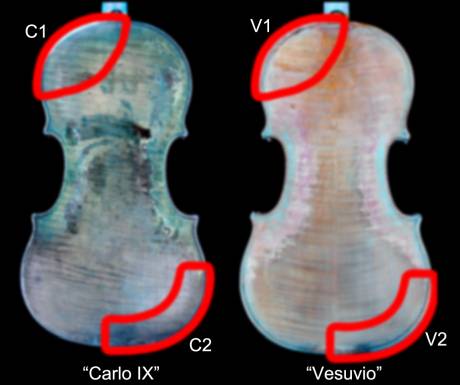This dataset includes multi-temporal UV Induced Fluorescence (UVIFL) images [1] of historical and sample violins acquired at Arvedi Laboratory of Non Invasive Diagnostics of University of Pavia. It can be useful for researchers interested in studying new methods for monitoring the state of conservation of artworks during time.
This is the first dataset of this kind public available. The use is allowed only for research, education and non-commercial purposes.
Dondi P., Lombardi L., Malagodi M., Licchelli M. (2019) "Segmentation of Multi-temporal UV-Induced Fluorescence Images of Historical Violins" In: Cristani M., Prati A., Lanz O., Messelodi S., Sebe N. (eds) New Trends in Image Analysis and Processing – ICIAP 2019. Lecture Notes in Computer Science, vol 11808. Springer, Cham, pp. 81-91 DOI: 10.1007/978-3-030-30754-7_9
Historical violins
Sample violins
Wood samples
Images were acquired with a Nikon D4 full-frame digital camera with a 50 mm f/1.4 Nikkor objective, 30s exposure time, aperture f/8, ISO 400. Two wood lamp tubes (Philips TL-D 36 W BBL IPP low-pressure Hg tubes, 40 Watt, emission peak ~ 365 nm), provided a uniform lighting in UV-A range (315-400nm).
|
"Carlo IX" made by Andrea Amati in 1566 (rarely played) and "Vesuvio" made by Antonio Stradivari in 1727 (frequently played) both held in Museo del Violino of Cremona (Italy).
Images were regularly acquired in three sessions from January to July 2017. We focused on top-left and bottom-right areas of the back plates since these regions are always in direct contact with the player, thus they are more likely subject to mechanical wear. The two instruments were also analyzed using various analytical techniques to accurately monitor their evolution during months [2]. The analysis returned no significant variations between sessions for areas C1, C2 and V1, instead slight alterations were detected in area V2. The filename format is the following: "AREA_SESSION_(NUMBER)png". For example, the first image of session 1 for area C1 is named "C1_S1_(1).png" |
 |
Sample violins:
Since the acquisition of multi-temporal data of historical violins is a very slow process, we are now simulating in laboratory the effect of a long-time use on wood samples and sample violins. We are testing various conditions and types of alterations. The description of the specific test for each sample can be found inside the corresponded zip file. New data will be added regularly as soon as available.
The filename format is the following: "TIME_NUMBER.png". For example, the three images for time t0 are named "T0_1.png", "T0_2.png", "T0_3.png" (filename format is different to easily distinguish historical and sample instruments).